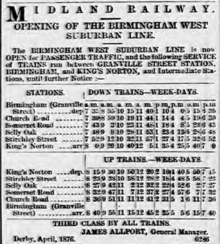Church Road railway station
Church Road | |
|---|---|
 Site of the station in 2011 | |
| General information | |
| Location | Edgbaston, Birmingham England |
| Coordinates | 52°27′58″N 1°55′16″W / 52.4661°N 1.9210°W |
| Grid reference | SP054853 |
| Platforms | 2 |
| Other information | |
| Status | Disused |
| History | |
| Pre-grouping | Midland Railway |
| Post-grouping | London, Midland and Scottish Railway |
| Key dates | |
| 1876 | Opened[1] |
| 1925 | Closed[1] |
Church Road railway station was a railway station in Edgbaston, Birmingham, England, on the Midland Railway's Birmingham West Suburban Railway.
History

The station, which was located in a cutting at the mouth of a short tunnel, operated between 1876 and 1925, before closing due to lack of patronage. Although the line remains open, almost no trace now remains of the station.[1]
On 7 July 1906 a passenger, Charles White, and his stepfather arrived at the station and purchased tickets for Birmingham New Street. As there was some time to wait for the train, they left the station and went into Carpenter Road. They were later observed on the southbound platform, and the elder man was struggling with Charles White, as if to restrain him from crossing the line. White broke free and jumped down into the adjacent tunnel. The station master, Mr Wilton heard the commotion and arrived on the platform, but unfortunately fell onto the track. As he lay there he witnessed Charles White being hit by a train. Although Charles White was not killed by the impact, he died in the ambulance on its way to Queen's Hospital, Birmingham.[2]
| Preceding station | Historical railways | Following station | ||
|---|---|---|---|---|
| Granville Street Line closed, station closed |
Midland Railway Birmingham West Suburban Railway |
Somerset Road Line open, station closed | ||
References
- ^ a b c "Church Road Station". Rail Around Birmingham and the West Midlands. Retrieved 1 April 2017.
- ^ "Railway Station Tragedy. Sensational affair at Church Road. A Platform Struggle". Birmingham Daily Gazette. England. 10 July 1906. Retrieved 27 March 2020 – via British Newspaper Archive.
External links
